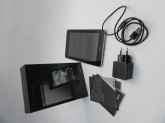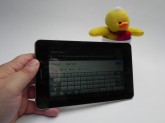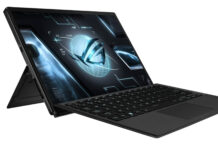The ASUS FonePad is a 7 inch tablet with phone call features, that was unveiled back at MWC 2013, where we also got some hands on quality time with the device. It’s priced at $249 and it was launched in April, but it’s only now that we got to fully review the product and enjoy its perks.
This device looks just like a Nexus 7 from the front and it brings forth a metal back as an extra. It measures 10.4 mm in thickness, weighs 340 grams and on the lower side of it we find the audio jack and microUSB port, while at the back we find the speaker, also on the lower area. All the buttons that matter, volume and On/Off were placed at the left, although I was expecting them to be somewhere at the top or on the right side.
There’s a microphone at the top and one at the bottom and I have to say that this device has big bezel edges. Basically, this slate looks like a bigger phone, especially due to that earpiece at the top. We also have a lid at the top back area, that houses the microSIM and microSD card slots. The ASUS FonePad has good build quality and can easily fit in the pocket of baggy trousers. We like its minimalistic look, but what we don’t like is the diminished grip compared to the Nexus 7.
On the hardware side, we get a 7 inch IPS LCD display with a 1280 x 800 pixel resolution (216 PPI density) and support for 10 finger multitouch. There’s also a microSD card slot on board with support for up to 32 GB of storage, 8/16 GB of internal memory depending on the version you buy and 1 GB of DDR2 RAM. HSDPA 21 Mbps connectivity is present among the specs, together with WiFi and Bluetooth 3.0. In some countries, there’s a special version of the FonePad with a 3.15 MP back camera, but we have the version that only has a front camera, a 1.2 megapixel camera.
Inside the device has an Intel Atom Z2420 1.2 GHz processor, a single core Lexington CPU with hyper threading and a Power VR SGX540 GPU with 400 MHz frequency. The slate relies on a 4270 mAh battery, that charges very fast, in about 2 hours or even less. We’ve got a power saving feature available and this device achieved about 8 or 9 hours of intense usage in our tests. You can also get 5 hours of continuous HD video playback from it, if you want another benchmark.
Moving on to the audio side of things, this device offers crisp audio, good volume and a loud and clear experience. We’ve got the Audio Wizard option for extra tweaking, with settings like Movie, Music and others. Sonic Master is the technology that grants us great acoustic here, courtesy of ASUS. On the video side, we’ve got great viewing angles, thanks to the IPS panel and a resolution of 1280 x 800 pixels.
The colors are good and the display settings are available in the notification area, allowing us to trigger a special Outdoor mode, for extra contrast. Needless to say that outdoor viewing is great, thanks to those contrast options. The text is crisp and sharp and colors are very natural, although blacks are not quite deep. In the software side we’ve got Android 4.1 Jelly Bean, a fast browser and comfy keyboard, plus a dialer that’s a typical aspect of handsets.
Speaking of which, the signal and voice quality are mint, but I do recommend you use an earpiece in order not to seem a douchebag with the tablet next to your ear. Back to the display for a bit, ASUS included a special app called ASUS Splendid, that allows you to tweak the viewing experience with custom colors, temperature, hue and saturation. On the benchmark side of things, we compared the ASUS Fonepad with the Nexus 7 and the Galaxy Tab 2 7.0.
In Quadrant we scored 2934 with the Fonepad, while the Nexus 7 achieved 4000 and the Tab 2 7.0 a mere 2900. In Antutu we scored a pretty good 9099 points, a bit lower than the 11k points of the Nexus 7 and certainly higher than the 6366 of the Galaxy Tab 2 7.0. Finally, in 3DMark we scored 2219 points, past the 2050 of the Galaxy Tab 2 7.0 but below the 3553 of the Nexus 7. In NenaMark we were also placed between the two with 38.8 FPS, versus 55.8 FPS and 26.3 FPS respectively.
ASUS bundles unique widgets with the device and mini apps triggered by a special virtual button at the bottom right of the screen. Those work like minisized window versions of apps, much like the mini apps of the Galaxy Tab devices and the Sony Xperia Tablet S. We also demoed the Instant Dictionary feature in the video review, that allows you to translate stuff from the screen in real time, just by dragging your finger on the screen. We’ve also shown you the dock area of the main apps, Google Now in action and the classical apps that ASUS bundles all the time.
I’m talking about App Backup and App Locker, plus the Google Maps, SuperNote Lite, a note taking app on steroids, with picture, audio and video recording included. There are also two new entries: ASUS Story, a collage and photo storyline maker and ASUS Studio, a glorified version of the standard gallery app. There’s also Buddy Buzz, a vaguely useless social networking app that tends to get blocked often.
Then comes Google Earth and My Painter, a drawing app that’s pretty basic. For your e-reading needs there’s MyLibrary and for extra storage, there’s the cloud solution ASUS WebStorage. And now here comes the verdict!
Here are the PRO aspects of the FonePad:
- metallic case, solid build
- great display, excellent contrast
- excellent audio, thanks to Sonicmaster tech
- good battery
- phone feature
- microSD card slot
- good price
- bundled apps
- fast charging
And the Cons:
- Android 4.1, not 4.2
- the lid at the top feels a bit flimsy
- less grip than Nexus 7
- low benchmarks
Overall, this is a very good tablet for its price and we give it a 9.2 out of 10 for design, 9.3 for hardware and a 9 for OS and UI. The final grade is 9.16 out of 10 and this is quite a solid purchase, if you don’t feel like buying a Galaxy Tab because of the laggy TouchWiz.
[youtube rghCHIR5ZFg 660 520]
Post Footer automatically generated by Add Post Footer Plugin for wordpress.










































